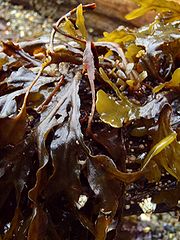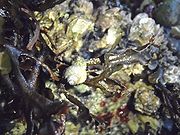((Fucus spiralis)
From marinelife1011
'Fucus spiralis
| Rockweed | |
|---|---|
.jpg) |
|
| Scientific classification | |
| Kingdom: | Protista |
| Division: | Heterokontophyta |
| Class: | Phaeophyceae |
| Order: | Fucales |
| Family: | Fucaceae |
| Genus: | Fucus |
| Species: | F. spiralis |
| Binomial name | |
| Fucus spiralis L. |
|
Contents |
Phylogeny & Description
Morphology
Fucus spiralis are in the phylum Phaeophyta of the brown algae seaweeds. Brown seaweeds are the largest and most structurally complex of the seaweeds. THey range in colours from olive green to dark brown and are normally very mucilaginous seaweeds. They are not true plants because they lack veins for transportation of water and nutrients. They have no leaves or roots and nutrients are absorbed through the thallus. The thallus (thalli) is the complete body of the specimen. The stipe is a stem like structure. The blades or flat leaf-like parts have the most surface area for the photosynthesis. The holdfast anchors the plant to a base and unlike plant roots the holdfast is not able to penetrate the surface. They have gas filled bladders, pneumatocysts, that are filled with air and mucilage. These pneumatocysts allow them to float towards the surface for the maximum amount of sunlight during photosynthesis and allow water to flow through the plant. Average growth of rockweed is 30 to 50 cm.
Ecology & Distribution
Geographic Range and Habitat
The Fucus species are found in the Atlantic and Pacific coasts of North America. Found in the mid to high tidal zone on exposed rocky shoreline habitats in both protected and unprotected areas. They are found throughout Puget Sound.
Fucus spiralis is found in the intertidal range with F. distichus from four feet down to seven feet. When the two are found growing in the same area F. spiralis is normally above F. distichus. It grows very well in rocky areas as they do not have roots but a holdfast that attaches to rocks and logs.
Life History
They are primary producers and provide habitat for many small invertebrates during all tidal stages. The plants have a defense against grazers; a polyphenol is secreted which inhibits digestion. Invertebrates that feed on them are the rockweed isopod, periwinkle snails, some limpets and crustaceans.
Fucus spiralis and F. distichus are very similar and grow in the same ranges. The Fucus spiralis has a more twisted thalli compared to the F. distichus especially when exposed to air. The terminal swellings are also more spherical then F. distichus and have hairs emerging from pits on the surface of the thalli.
Reproduction
Reproduction
The Fucus spicies are the most advanced of the brown algae seaweeds. Brown seaweeds have the most advanced reproductive system of the red and green seaweeds. Sexual reproduction occurs in the tips of the pneumatorysts. When the tide goes out the tips shrink and the ripe gametes are squeezed out in the drops of mucilage. As the tide returns all the gametes are collected in a concentrated mass and this enhances the survival of a successful union with other plants. When an egg is fertilized it is able to attach to a rock where is will grow into an adult. Plants are also able to reproduce asexually. When a piece of the thallus breaks off it is able to continue growing and form a new plant.
Human Use
Rockweed is harvested from May to September from special boats using a rake that cuts the plant 16 cm above the base to allow the plants to grow back. Rockweed is used in packing crates for seafoods, fertilizers for agriculture and horticulture. It is put into toothpaste, fillers in ice-creams, jams, preservatives and salad dressings. Rockweed is also high in B12 and used in vitamins and other natural supplements. Historically used by the Native Americans on the Olympic Peninsula to treat sunburns and cuts using the gel inside the bulbs.
Conservation & Preservation
Conservation/Preservation
Rockweeds are very common in the Puget Sound region they provide important habitat to intertibrates. They help to hold the shoreline during strong currents and wave activity. They also help to filter the water and produce oxygen.
There is no conservation in action for the Fucus species in Puget Sound however non-native seagrasses are being monitored and removed by hand in area. If actions are not taken against non-natives the native flora and fauna could be disrupted and pushed out of its habitat.
References
Dinsmore, Sandra. "Rockweed Provides Jobs in Jonesport." The Working Waterfront. N.p., 19 Oct. 2010. Web. 28 Feb. 2011. <http://www.workingwaterfront.com/articles/Rockweed-provides-jobs-in-Jonesport/14076/>.
Kozloff, Eugene N. Seashore Life of the Northern Pacific Coast: an Illustrated Guide to Northern California, Oregon, Washington, and British Columbia. Seattle: University of Washington, 2000. Print.
Office of National Marine Sanctuaries. "Olympic Coast National Marine Sanctuary Seaweed Species List." Welcome to the Olympic Coast National Marine Sanctuary. N.p., 16 July 2004. Web. 20 Feb. 2011. <http://olympiccoast.noaa.gov/living/seaweeds/seaweedlist.html>.
Student Scientists on Our Sanctuary Shores. "LiMPETS: Rocky Intertidal Monitoring - Flattened Rockweeds." LiMPETS: Long-term Monitoring Program & Experiential Training for Students. N.p., 2010. Web. 18 Feb. 2011. <http://limpetsmonitoring.org/algae_flattened.php>.
Wernert, Susan J. Reader's Digest North American Wildlife. Pleasantville, NY: Reader's Digest Association, 1983. Print.
White, N., (2000) Fucus vesiculosus. Bladder wrack. Marine Life Information Network: Biology and Sensitivity Key Information Sub-programme [on-line]. Plymouth:Marine Biological Association of the United Kingdom. (February, 2011) http://www.marlin.ac.uk/species/Fucusvesiculosus.htm
Williams, Susan L., and Megan N. Dethier. "High and Dry: Variation in Net Photosynthesis of the Intertidal Seaweed Fucus Gardneri." Ecology 86.9 (2005): 2373-379. Print. 27/1/2011




